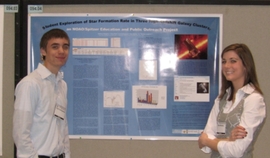We propose to study the evolution of star formation in galaxy cluster environments by making measurements at epochs between 0.54 < z < 0.63. We will measure the integrated SFRs for three optically selected galaxy clusters from the ESO Distant Cluster Survey (EDisCS) using MIPS 24µm photometry. We will measure total past SFRs, i.e. stellar masses, from rest-frame near-infrared (near-IR) photometry obtained with IRAC. Two of the three galaxy clusters already have IRAC data. We propose taking new IRAC data for CL1232.5-1250 to complete the set. We have found that H..-derived starformation rates depend on both cluster mass and redshift, demonstrating the necessity of sampling a large range in mass to disentangle evolutionary trends from trends in mass. Our three targeted clusters span the range in mass from neargroup environment to the most massive cluster in the EDisCS sample.
This mass range fills the gaps in existing studies, which are dominated by studies of field environments or of very massive clusters. The Spitzer MIPS 24µm observations are needed to make a comprehensive measurement of the star formation rates in galaxies, because extinction by dust can completely obscure the majority of star formation in galaxies. The IRAC observations will determine if AGN activity is present in individual galaxies, which would bias our measures of the SFR based on the 24µm flux since the AGN could also heat dust seen at 24µm. The IRAC data will also provide robust stellar masses to quantify the total past star formation. We will observe the central 5'x5' of each cluster with MIPS in 24µm and with IRAC in all four channels. Our 24µm observations will reach a sensitivity of one solar mass per year and our IRAC depth is chosen to match the same SFR sensitivity.
Extensive ancillary data are already in hand, i.e. deep VRIJK imaging, 8-meter telescope spectroscopy, HST I-band imaging for all three clusters, and IRAC data on two of the clusters. This ancillary data will help to isolate cluster members and interpret the derived SFRs. The mass and redshift range of our targets serves as an important complement to other Spitzer studies of low and intermediate-redshift clusters and will provide a more comprehensive picture of the evolution of star formation in galaxy clusters from z ~ 1 to z ~ 0.
South Anchorage High School, Anchorage, Alaska
Phillips Exeter Academy, Exeter, New Hampshire
Graves County High School, Mayfield, Kentucky
Oregon Episcopal School, Portland, Oregon
Grosse Pointe North High School, Grosse Pointe, Michigan Vera C. Rubin Observatory, Tucson, Arizona
Saint Joseph's High School, South Bend, Indiana
South Anchorage High School, Anchorage, Alaska
